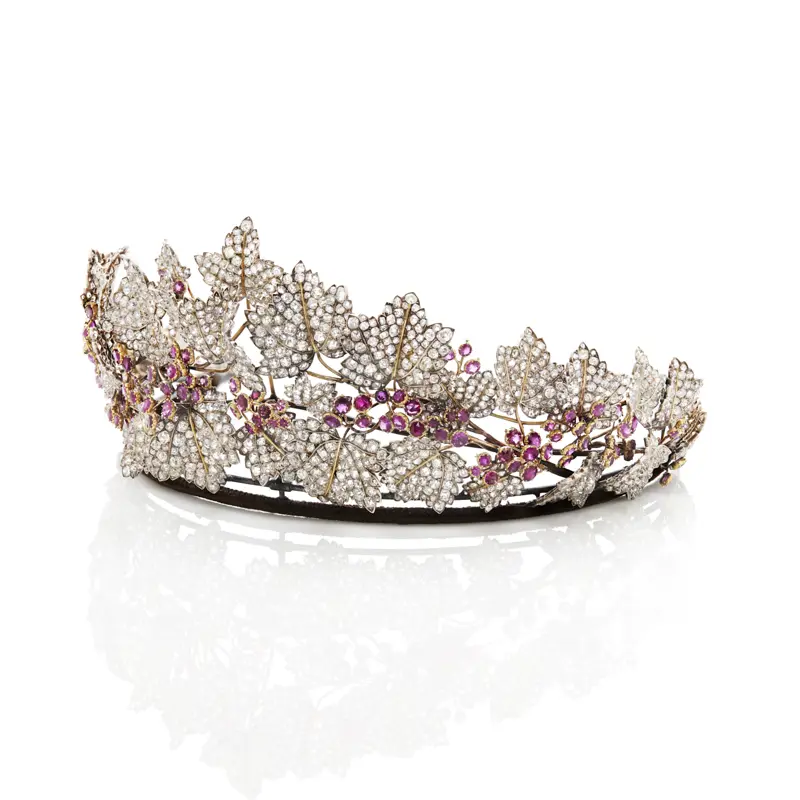
The danish crown jewels, Frederik IX’s pipe collection and the more than 400-year-old Rosenborg wine are among the many objects that appear in the program series „The Queen’s Treasury“, which from tonight and the next Tuesdays will be broadcast on DR 1.

The museum collection Kongernes Samling contains Danish kings and queens‘ central objects and works of art, and the program series follows the creation of the exhibitions „A Queen’s Jewelry Box“ and „Mary & the Crown Princesses“, which are currently on display at the Amalienborg Museum and Koldinghus, respectively.
The exhibitions have been created in collaboration with Her Majesty the Queen and Her Royal Highness the Crown Princess, and the programs are included when the Queen and the Crown Princess take part in the preparations for the new exhibitions. The first episode of „The Queen’s Treasury“ will be broadcast tonight at 20.30 on DR1.https://www.dr.dk/drtv/se/dronningens-skatkammer_-smykker-der-taler_307886
Crown jewels and fideikomis jewels
At special events such as state visits, the New Year’s table and other major events where a gala is worn, the female members of the royal family like to wear historical jewellery. Often as sets, also called garnishes, with a tiara and earrings, necklace and possibly bracelet. The jewelery is partly the crown jewels, partly jewellery, owned by the Danish Royal House’s Løsørefideikommis and jewelery privately owned by the Royal House.

The crown jewels
The best-known pieces of jewelery are the crown jewels, which primarily consist of four large jewellery sets: a brilliant set, an emerald set, a pearl-ruby set and a rose stone set. The crown jewels belong to the Crown, i.e. the monarch and his queen. After the change of throne, they are therefore available to HM Queen Mary. When the crown jewels are not in use, they are displayed in the treasury in the secured basement under Rosenborg Castle.
It is customary for the crown jewels to remain in Denmark, which means that they are not taken with them when visiting abroad. The Danish crown jewels are the only ones in the world that are both exhibited as museum objects and at the same time worn by the country’s queen.
The history of the crown jewels goes back to Christian VI’s queen, Queen Sophie Magdalene, who in her will from 1746 decided that her jewelery should not pass to one specific person, but always be available to the country’s sitting queen on the grounds that „there in this royal house there are so few jewels and no crown jewels at all“. Most of Queen Sophie Magdalene’s original jewelery has been remade by subsequent queens as jewelery fashions have changed. Today, the four crown jewel sets have the design that Christian VIII’s queen, Queen Caroline Amalie, gave them in 1840.
The jewelery in the Danish Royal House’s Loose Trust Committee
Another group of striking jewelery is the jewelery from the Danish Royal House’s Loose Trust Committee. These pieces include, among others, the Perlepoire set of tiara, necklace, earrings and brooches, the large diamond necklace, called the Rivière , and the diamond frame with royal portrait worn by the Queen at the gala.
The Royal Trust Trust was founded by Frederik 8th and Queen Lovisa in 1910. The purpose was to collect and secure gold, silver and other valuables „that are desired to be preserved in Our Family and therefore must pass undivided from King to King of our House“.
The objects in a fideicommis are inherited in the family. They are not owned by the individual person, and a sale or mortgaging of the inheritance is therefore not possible. In the Royal Trust Committee, this means that important collections – not least the co-founder, Queen Lovisa’s great legacy from her Dutch, German, French and Swedish ancestors – have been able to be kept together in the Royal House.
The Commission of Estates jewelery is worn by the sitting Queen and can be taken abroad for use at gala events.
The royal family’s private jewelery
The queen and the other women in the royal family also have a collection of private jewels which they themselves dispose of.
In Queen Margrethe’s collection, you will find, among other things, the palmette tiara and the sapphire set with necklace and earrings, which Frederik IX had made as a wedding present for his daughter, the successor to the throne, Princess Margrethe. Other important pieces of jewelery are the ruby and pearl set, which was a silver wedding gift from Prince Henrik, and the Greenlandic gold diadem, the flower diadem Naasut – a gift from Greenland in connection with the 40th anniversary of the government in 2012.
In the future Queen Mary’s jewelry collection, you will find the old Russian turquoise and brilliant jewelry that Queen Margrethe gave to her daughter-in-law on her 50th birthday in 2022, and a slender diamond tiara that can also be used as a necklace, and which the future queen herself has purchased at auction.
The most well-known of the privately owned pieces of jewelery worn by the future queen is probably the ruby set, given to the future king by her maternal grandmother Queen Ingrid. The set was made for French Marshal Jean-Baptiste Bernadotte’s wife Desirée and was worn at Emperor Napoleon’s coronation in 1804. The set came to Sweden via the Bernadotte couple when they were appointed Crown Prince Couple of Sweden. Desirée, who in 1818 became Queen Desideria of Sweden, then let it go to her daughter-in-law Josefina. As queen dowager, in 1869 Josefina presented the set to her granddaughter, Princess Lovisa, at her wedding to Danish Crown Prince Frederik (8th) with the reason „the Danish colors for Louisa“.
